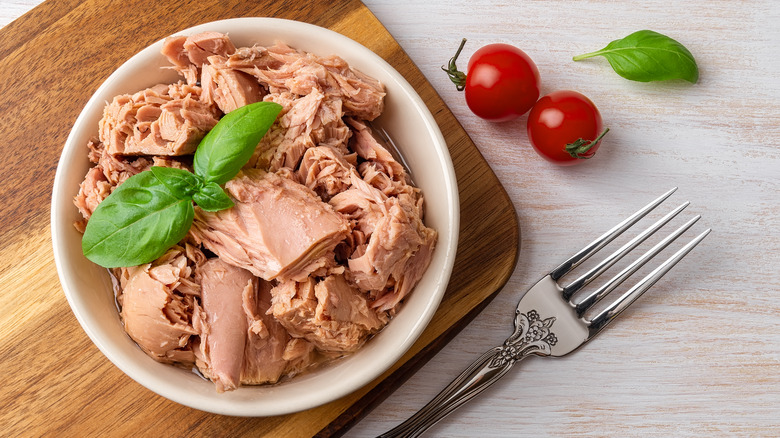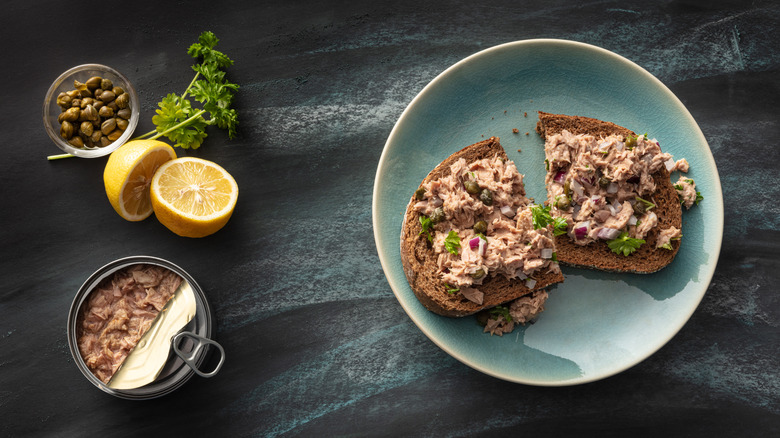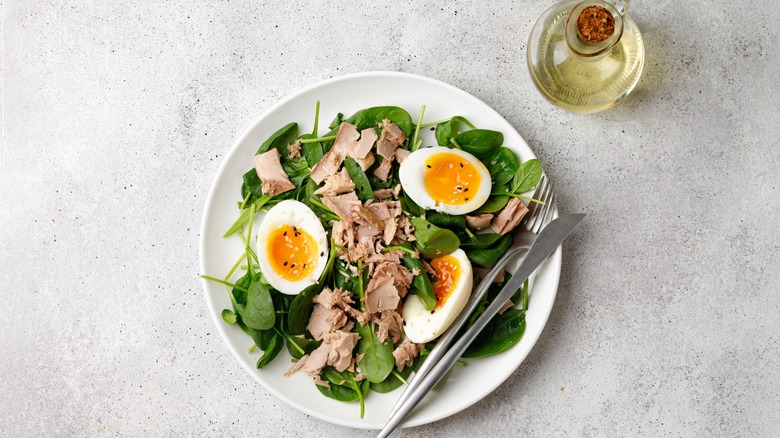Hold On, Is Canned Tuna Cooked Or Raw?
If you're a fan of canned tuna, you'll be happy to know it's safe and ready to eat straight out of the can since it is pre-cooked for your convenience. Canned tuna is a wonderful seafood option, considering not everyone has access to fresh fish, not to mention it's super affordable. You can get your fish fix from a can sold in grocery stores instead of a fish market, and you don't even have to cook it. The shelf life is also extremely long, typically around two to five years, making it convenient to store in your pantry and grab when needed.
The process of canning tuna typically starts with frozen tuna that arrives at the facility straight from a catch, which is subsequently thawed and steamed in large batches. After cooking and cooling, the tuna is skinned and deboned, and the meat is canned with salt and liquids such as oil, water, or vegetable broth. The cans are vacuum-sealed and sanitized to kill any bacteria, which contributes to their long shelf life.
Fresh tuna is admittedly delicious and is often served raw or rare in sushi, sashimi, or on its own as a delicacy. But if you want tuna that will last, doesn't have to be refrigerated (before opening), and is perfect for salads, sandwiches, and casseroles, canned tuna is where it's at. You can even pop open a can and eat it plain for lunch (although your coworkers might not love the smell).
Creative canned tuna recipes
Not everyone loves the look and smell of canned tuna, but there are plenty of creative recipes that incorporate it into appetizing and aesthetically pleasing meals. For an upgraded tuna sandwich, try a canned tuna open-faced sandwich that looks as fresh and delicious as it tastes. The crusty bread used in this recipe gives you a satisfying crunch instead of that soggy bite that typical tuna sandwiches sometimes have, while the chives, scallions, chili flakes, and lime juice are enough to mask any unwanted fishiness from your canned tuna. You can use oil-packed tuna or tuna in water and add a tablespoon of oil to the mixture.
If you like crab cakes, you'll love this pan-fried tuna patties with sriracha mayo recipe by professional chef Deniz Vergara. These mouthwatering crispy tuna patties prove that canned tuna isn't just for salads and sandwiches. The tuna is combined with egg, mayonnaise, and breadcrumbs to form the patties, along with flavorful and fragrant ingredients like onion, scallions, cilantro, dijon mustard, garlic powder, and lemon juice. They're pan-fried in avocado oil (which has a mild, slightly nutty flavor) until golden brown and served hot with a spicy homemade sriracha mayo. This recipe is the perfect way to elevate your canned tuna and create something beautiful and delicious that makes a great meal or party appetizer.
Is canned tuna good for you?
People often associate canned goods with being unhealthy due to the high levels of sodium used as a preservative. Indeed, canned tuna can have higher sodium levels than fresh tuna, but it depends on the variety you choose. For example, Starkist's solid white albacore tuna in water has 320mg of sodium per 5 ounces. However, many canned tuna brands now offer low-sodium versions, such as Starkist's light tuna, which has 25% less sodium (270mg per 5 ounces).
Canned tuna, just like fresh tuna, has a nutritional value that includes being low in fat (particularly when canned with water instead of oil) and high in protein and other nutrients. According to All Recipes, registered dietitian Trista Best, MPH, RD, LD, says, "Canned tuna is a good source of omega-3 fatty acids, particularly EPA and DHA, which are beneficial for heart health and brain function, and it also contains essential vitamins and minerals, like vitamin D, vitamin B12, selenium, and potassium."
Keep in mind that canned tuna, like other seafood, contains varying levels of mercury depending on the variety. The FDA recommends that those who are pregnant or breastfeeding, as well as children, should consume seafood that is lower in mercury. Canned light tuna, such as skipjack, is included as one of the best choices for a variety of tuna that is low in mercury, while other varieties, like bigeye tuna, are on the choices-to-avoid list for being high in mercury.


